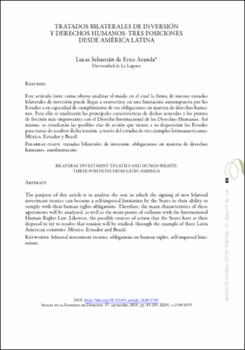Tratados bilaterales de inversión y derechos humanos: tres posiciones desde América Latina
Fecha
2020Resumen
Este artículo tiene como objeto analizar el modo en el cual la firma de nuevos tratados
bilaterales de inversión puede llegar a convertirse en una limitación autoimpuesta por los
Estados a su capacidad de cumplimiento de sus obligaciones en materia de derechos huma-
nos. Para ello se analizarán las principales características de dichos acuerdos y los puntos
de fricción más importantes con el Derecho Internacional de los Derechos Humanos. Así
mismo, se estudiarán las posibles vías de acción que tienen a su disposición los Estados
para tratar de resolver dicha tensión, a través del estudio de tres ejemplos latinoamericanos:
México, Ecuador y Brasil. The purpose of this article is to analyze the way in which the signing of new bilateral
investment treaties can become a self-imposed limitation by the States to their ability to
comply with their human rights obligations. Therefore, the main characteristics of these
agreements will be analyzed, as well as the main points of collision with the International
Human Rights Law. Likewise, the possible courses of action that the States have at their
disposal to try to resolve that tension will be studied, through the example of three Latin
American countries: Mexico, Ecuador and Brazil.





